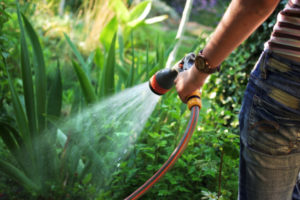
Key factors affecting how often and how much you should water include:
- Soils – Soil texture influences how much moisture the soil can retain, and for how long. This will affect how long it takes to moisten the rootzone, and how quickly the soil will dry out again.
- Your Plants’ Needs – Some plants need regular watering; others less. How you water new plants affects root development, which also affects their “thirstiness”.
- Sun/Shade/Exposure – Sun, shade, and wind affect how much water evaporates from the soil.
- Watering System – How fast or slow your system applies water affects how much water is absorbed or is wasted by runoff and evaporation.
Trees
When to water:
- Young trees planted within the last 5 years need water twice a week during the hot, dry summer months. Don’t wait until they show signs of drought stress.
- Most established trees, if well mulched, need no watering except in drought years. Watch your trees for signs of wilting or yellowing leaves – that means it’s time to water.
- Trees planted in the fall are more likely to survive our hot, dry summers and will need less water.
How much to water:
- Young trees planted within the last 5 years need 15 – 20 gallons of water twice a week.
- Water should be applied directly to the roots. The most efficient way to water young trees is by using a 15 or 20 gallon water bag. Another way to do it is to set several 5-gallon buckets with small holes drilled into the bottom around the base of the tree and fill those with water.
- Water mature trees, if necessary, once or twice a month. Place a soaker hose circling the tree toward the edge of the canopy, NOT at the base of the tree. Use a hose faucet timer to prevent overwatering.
Shrubs and perennials
When to water:
- Varies widely by plant (see above). Many established plants need little or no summer watering, so become familiar with your plants’ needs.
- Look for wilted leaves that don’t perk up in evening, deciduous leaves that are yellow before autumn, or evergreen leaves that are dull or bronze.
How much to water:
- Water deep enough to moisten the whole root zone (6 to 12 inches). Dig into the soil before watering to see if water is needed, and an hour after watering to check for adequate moisture.
Annuals
When to water:
- Soil is dry below the surface.
- Try not to let annuals wilt – many will be stunted or die if allowed to dry out.
How much to water:
- Check the soil often to make sure it’s moist 1 or 2 inches below the surface.
Lawns
When to water:
- Dull green color.
- Footprints in the lawn remain longer than a day.
Or let lawns go brown and dormant – they’ll bounce back in fall!
- Let lawn areas that don’t get heavy wear go brown and dormant. Just water once a month. In the fall you can thicken any worn areas by raking and then overseeding, see Lawn Care.
How much to water:
- In July, lawns need about 1 inch of water per week, spread over 2 or 3 waterings, to stay green. They need only ½ to ¾ inch per week the rest of the summer (use a tuna can to measure sprinkler output). Watering deeply and less often is generally best, to moisten the whole root zone.
- Lawns allowed to go brown do best if watered deeply once a month in summer to keep the roots alive.
Quick tips
- Check the soil before you water. Probe with a finger or trowel to see if the soil is still damp a few inches down. When it’s dry down at the root zone, it’s time to water.
- Water deeply, but less frequently. An hour after watering, check the soil again to see if the water has reached the rootzone. Adjust your watering time to moisten the whole root zone, but then wait until the upper few inches of soil are dry before watering again, which encourages deeper roots.
- Water slowly to prevent runoff and give water time to move deeper into the soil. If water puddles on the surface before it is absorbed by the soil, start and stop your watering several times, as needed, to allow the water to soak in.
- Get water right to the roots in small areas by using a watering wand with a shutoff valve. For larger areas, drip irrigation or soaker hoses, under mulch, deliver water efficiently right to the roots.
- Make every drop count. Water early or late in the day to reduce evaporation, build your soil with compost and mulch, and choose low water use plants. Take a Savvy Gardener Class to learn from the experts!
- Questions? Call the Garden Hotline at (206) 633-0224 or email help@gardenhotline.org